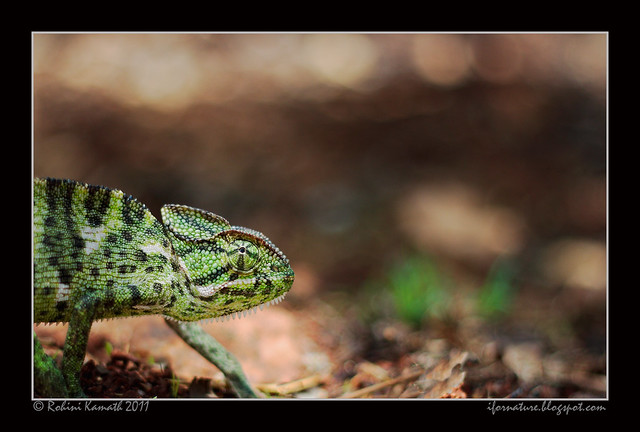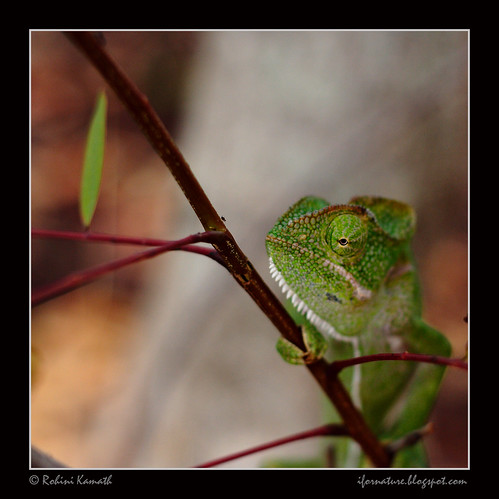
In the shade, on a small bush by the roadside
Due to the overcast weather which looked like rain, we decided to leave late and took a detour to the Hoysala Bhoganandishwara Temple ( a post on this soon, I promise) before going up to Nandi Hills for lunch in their Mayura Restaurant.
Enroute to the temple, we were at a decent speed on empty roads when Keshav suddenly yelled "Stop Stop"! I thought it was a snake he had spotted, I had barely stopped that he was out like a rocket and running back down the road, camera in hand.
A few minutes later, I had parked, recovered my senses, got my camera from the boot, and walked back round the bend to find him prostrate in the presence of the cutest little critter ever! Our first Chameleon!
Not to be confused with a common Garden Lizard, or a Rock Agama, a chameleon is a totally different reptile all together.

Curious Garden Lizard - archive image
Chamaeleo Zeylanicus is commonly known as the Indian Chameleon. There is only one species of chameleon in India. They are common in Africa and Madagascar, spread over Europe and parts of Asia. They have been introduced to North America.
Chameleon Common Facts:
1. They move slowly, almost in slow motion, and in a very hesitant, unsteady way.
2. They have a long tongue having a sticky end, which serves to catch prey that they would otherwise never be able to reach with their lack of speed.
3. They can move their eyes independently of each other. Having one looking ahead while the other looks behind. This gives a full 360 degree of view.
4. They hear vibrations in the air, which help them find food and stay safe from their enemies. They are almost deaf - they have no external ear.
5. They have 5 digits on each foot. But they are grouped as 3 and 2. Two opposing digits gives a better grip. The digit grouping is reversed in the rear feet.
6. They are cold blooded and need the sun to regulate body temperature.
7. They have small teeth. They eat mainly insects and larger species eat small birds and reptiles.
8. They lay eggs in a hole in the ground. Some species (ovoviviparous species) give birth to live young.
9. They are non-venomous. But if you are bitten by one, there is chance of infection.
10. They have a prehensile tail, they are the only lizards which have such a tail.

While in the sun in the open, it looked like this
Colorful Ideas
They change color according to their background for camouflage - Wrong! (Personally I was surprised too )
They change color according to emotions - Excitement and fright produce pale shades with brown patches and yellow spots. Anger causes darkening.
They also use color change to regulate their body temperature. Dark colors absorb heat better, so the side of the chameleon facing the sun becomes darker, while the other side remains its usual color.
It is also believed that they can communicate with other chameleons using color. During the mating season (in India around October) they turn their skin bright green while during fights they turn Dark brown. The Indian Chameleon is normally grey-green, but in total darkness this fades to a cream color with irregular yellow spots.
They can however change color for camouflage as well, but only in a limited way.
They aren't the only ones, several other species of lizard have that ability too.
Chameleons and other indian reptiles do not shoot blood out of their eyes - this property is that of the Horned Lizard (North American) which shoots blood into the eyes of foxes and coyotes ( which the predators find foul tasting ).

Size comparison, with an Ant
Getting Close
While we wanted to avoid doing an Austin Stevens on our little friend, we did have to get a little close due to the choice of lens ( I had a 50mm f1.8) we each had on our cameras. Our little guy was so small and cute, the urge to touch was very great, but we valiantly resisted.

How to photograph a chameleon - passersby were very amused
I'm happy to report that our little critter was mostly unconcerned by our presence based on the research Ive been doing. When upset, chameleons change color rapidly and if one gets too close, it makes a "Haaaaa" hissing noise similar to a snake.
We did not get either of the reactions, so I think we did well.
So what should you do when you encounter a chameleon? You'd want to keep it safe out of harms way, help it cross the road and see it safely into a nearby bush. Handle it gently and treat it kindly.

Keshav's shot with new Macro lens
Its a Boy!
Distinguishing male from female is not easy. The indian male (chameleon) has a spur on the rear feet to identify it as one. Based on this info, I have concluded that our little guy is a Guy! Experts feel free to point out any mistakes.
Sources and Links:
iFornature
Wikipedia
Auroville
Kalyan City
Where In City






5 comments:
Nice one Rohini. Thanks for all the info.
Superb Photography & a nice writeup..
WOW.. it's real hardwork behind this to get this colourful chameleons. Hats off
wow! beaituful shots & nice piece of info!!
amazing animal
Post a Comment
Please do not post ADs here, they will not be published. All comments are moderated.